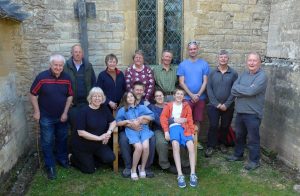Eleven members of Bicester Branch arrived at the first tower, Freeland, a light ring of 6 (3 cwt tenor) which proved to some of us to have a rather elusive entrance. Freeland is where Anthony Cole was Tower Captain a while ago. A recent refurb of the bells and relocation of the clock has freed up space to the ringing chamber, which, when found, is still a snug space, but with room for four non-ringers to sit.
We rang touches of Bob Doubles, Grandsire Doubles and Bob Minor, plus plain courses of Reverse Canterbury. I tried my first call unaffected of plain bob Doubles, but needed quite a lot of prompting from Anthony. Practice makes perfect…
On to our next church, North Leigh. This is a beautiful small church with some fascinating architecture, including a fan-vaulted ceiling, rarely found in a parish church. In contrast to Freeland, North Leigh’s ringing chamber is very spacious, appearing to have room for two more ropes.
This is where Anthony learned to ring. Needless to say, Anthony’s name is on a number of peal boards on the walls.
Again, we rang touches of plain bob and Grandsire Doubles including a version involving successive calls of singles. Sam trebled to a couple of touches.
Back to Freeland for lunch at the Yeoman pub, then suitably refreshed, we went to Witney our third tower. Witney church is large and bears the hallmarks of historic wool town prosperity, one example being a gallery surrounding the ringing chamber and a fine ring of eight (16 cwt tenor). Conscious that the tower captain may be listening to us from a nearby coffee shop, we limited our ambitions to Plain Hunt on 7, a passable couple of plain courses of Grandsire Triples and call changes on 8.
Onto the fourth tower, Ducklington, which unfolds its historic charm as you progress further into the village, where the church lies next to the village duck pond and old school house. Ducks were in attendance in the churchyard, naturally, and we had to keep the church door shut to keep them out.
We seem to have embarked on a tour of the Cole family ringing roots, as Ducklington was Sarah’s first tower. The ring is light and improvements have been made to the ringing chamber, with a balcony giving space to non-ringers.
Here we rang Grandsire plain courses and touches, Sarah called a touch affected of Bob Doubles and we had some more Reverse Canterbury.
Anthony also gave Penny Wood a back stroke handling lesson.
And then to Yarnton, our final tower of 6 bells, with the heaviest ring of the day, whose tenor weighs in at 21 cwt. The bells met with approval of several of the ringers, including also fond reminiscences of ‘proper ringing’ in the days before this peal was rehung , when the bells were on plain bearings and the ringing chamber was on the ground floor with a long draught without guide holes.
Anyway, the modern day pampered ringers warmed up to Plain Hunt on 5 and 6, some plain courses of Bob Minor (giving Anthony the chance to heave the tenor about), more touches of Grandsire and plain bob doubles, including another attempt by the author to call unaffected, better but just forgot to say ‘that’s all’ at the right point.
Penny also had another back stroke handling lesson, showing commendable technique.
All in all, a very pleasant day’s ringing outing, thanks to Jeremy Adams’ excellent organisation.
At the end, before the team photo, I spoke to two German tourists outside the church. What little they knew about change ringing was that it can often have fatal consequences, based on viewing episodes of Midsomer Murders 😉

Steve Vickars
